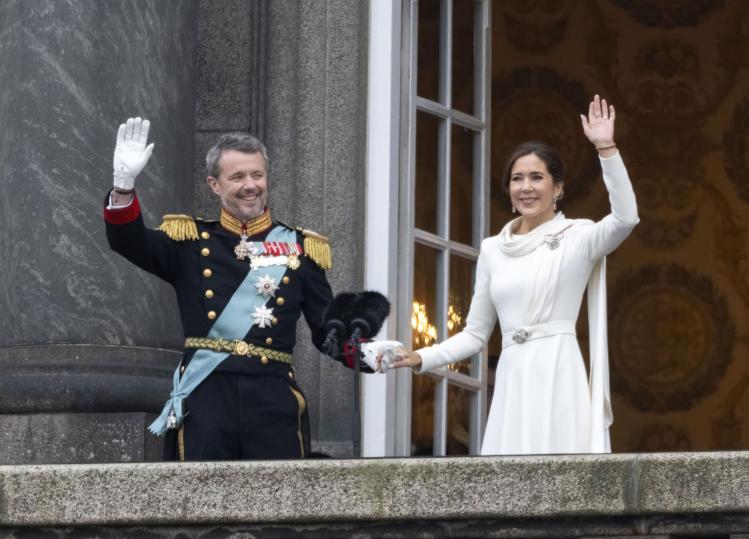
From certain angles, Copenhagen resembles a toy town, a dollhouse city. As one strolls through its center, it seems natural that LEGO was invented in Denmark. Look at the buildings in their pretty pastels of pink, yellow, and red. Look at the draft horses that cart barrels of Carlsberg around. Look at the Royal Life Guards in their red jackets and bearskin hats, marching like an elite squad of tin soldiers.
But nothing in recent memory has made the city seem more toy-like, more make-believe, more childish, than all the pomp and ceremony that surrounded King Frederik X’s ascension to the throne in January. A little context is probably in order: in her annual New Year’s Eve address, former queen Margrethe II announced her decision to abdicate the throne on January 14 of this year, thus ending her fifty-two-year reign as Denmark’s sovereign and installing her eldest son, former crown prince Frederik, as king.
The queen’s shock decision unleashed such a frenzy of mawkish newsprint and fawning media coverage it was enough to make even Kim Jong Un blush. For weeks, Danish media was aglow with tributes to the wisdom and courage of the departing queen. Christian Jensen, the editor in chief of Politiken, a newspaper founded by the left-wing agitator Viggo Hørup, praised Queen Margrethe for having “united, shaped and formulated a common language and direction for the nation.” TV2, a government-owned broadcast and television company, announced plans to create a historical drama series about the life of Queen Margrethe titled By the Grace of God. The theater critic Jakob Steen Olsen mourned the “closing of a chapter of Danish history” and, in prose plumed and crested with every possible cliché, hailed the queen for always putting the monarchy first, even, apparently, at the expense of her own personal needs. (To which one might add that, in 2023 alone, the queen pocketed 92.6 million Danish kroner—about $13.3 million—of taxpayer money).
Then came the excitement and anticipation for the incoming royal couple, King Frederik and his Australian-born wife, Queen Mary. Instantly, six different books by or about members of the royal family shot onto the list of the top twenty best-selling titles in Denmark. It was for some reason deemed newsworthy that the Danish tennis pro Caroline Wozniacki has “a good relationship” with the new royal couple and thinks they’ll do a “fantastic” job. It even made Danish headlines when the New York Times referred to the new Queen Mary as “progressive” and “down-to-earth.” Clearly, the Danish media was not going to be distracted from the coronation by anything less than World War III.
When the day at last dawned, three hundred thousand people (roughly the population of Cincinnati) converged on the wind-scoured capital to witness King Frederik X and Queen Mary take the throne. Actually, since the accession itself was simply a matter of the former queen signing a decree and lasted only a little over a minute, there wasn’t anything for the tens of thousands of people whooping and cheering in the frigid cold to see, but at least they were subjected to two titanically boring speeches by the unctuous Prime Minister Mette Frederiksen and the newly crowned king himself.
“I must confess I shed a tear,” Tom Jensen, the editor in chief of Berlingske, later wrote in his account of that day. Standing there with his enthralled fellow Danes, the significance of the occasion dawned on him with the force of an epiphany: “The Sunday King Frederik X was crowned, we were reminded that we’re here together. And that was enough for me. Because that really is everything.”
When I moved back to Copenhagen this past fall, I wanted very much to believe all the recent hoopla about Denmark as a haven for the hip and progressive. But behind the climate-conscious hipster surface is the same old piety and parochialism I remember from growing up here in the nineties and early aughts: according to one recent poll, as much as 79 percent of the population supports the monarchy. The current government has even announced plans to increase funding for the royal family, which already costs about 500 million Danish kroner a year, with barely a whisper of protest to be heard anywhere.
What’s strange is that no one seems to acknowledge the glaring contradiction between Denmark’s vaunted egalitarianism and its slavish royalism—not even the supposedly left-wing parties, which ought to be opposed to the monarchy as a matter of principle. Pia Olsen Dyhr, leader of the democratic-socialist Green Left Party, proudly participated in the Danish parliament’s official ceremony marking King Frederik’s ascension. Meanwhile, the Social Democratic Party announced in January that it would no longer prohibit its members from receiving royal honors, thus breaking with its own history as the party of the Danish labor movement. To put it a little provocatively, Denmark is a historical anomaly: the world’s first socialist monarchy.
Try to point this out to the average Dane and you’ll be met with the patient, pitying stare reserved for the obviously unwell—or accused of “suffering from spiritual and cultural anemia,” as Karoline Haarder put it in Berlingske. This is not, by the way, an attitude shared only by older generations or the hopelessly retrograde. I have frequently heard otherwise progressive Danes my own age insist on the importance of the monarchy by using terms like “unity,” “stability,” “national cohesion”—using, that is, conservative language implying Denmark’s political institutions and cultural history are insufficient to guarantee some measure of stability and cohesion.
If, as everyone here seems to agree, the new king and queen are so progressive and modern, then why not do the progressive and modern thing and relinquish the sovereign’s executive authority over the government? Safely divested of its political function, the royal family could even remain as the lucrative tourist attraction all Danes stubbornly insist it is. Until such an unlikely time, though, the idea that Denmark is a beacon of progress will remain the country’s most maddening fairytale of all.

